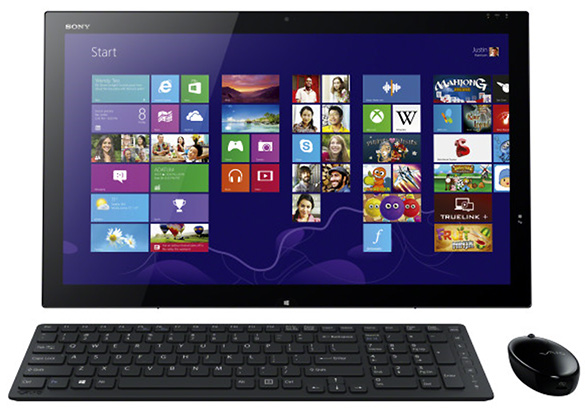Sony VAIO Tap 21 Multitouch Mobile Desktop Review
The Sony VAIO Tap 21
Sony did a great job with the aesthetics on the VAIO Tap 21. We had some experience with the previous-gen Tap 20, which didn’t quite impress. This new version, however, is clearly superior—not only in terms of build quality, but appearance as well. The VAIO Tap 21 has more distinct curves, tighter tolerances, and the system itself is constructed of better quality materials.
To look at the VAIO Tap 21 from the front, is to see nothing but screen. The system is outfitted with a very nice 21” touch-screen, with a full HD resolution of 1920x1080. The panel leverages Sony’s TRILUMINOS technology, which is to say it can display a wide color gamut, and it’s built using IPS (in-plane switching) technology, for greater color accuracy and wide viewing angles. More often than not, the panels used in all-in-one systems are less than ideal, but Sony’s got a winner here. The panel on the VAIO Tap 21 is excellent. It’s bright and crisp, colors look great, viewing angles are very good, and it offers good brightness.
Touch response is also excellent on the Sony VAIO Tap 21. We had no trouble at all with the machine recognizing touch input and in apps that showed taps, recognizing 10 fingers was instantaneous. The touch experience is as good as we’ve seen on a Windows 8 system. And as you’d expect from a Windows-based, touch-enabled device, there is a Windows / Home button right at the bottom of the screen. Hidden in the bezel, at the very top of the screen, is an integrated 1MP webcam. The webcam is adequate for basic video chatting, but the quality is not terribly good.
The back of the VAIO Tap 21 is much less exciting, but still nice to look at in our opinion. It’s essentially a large, silver expanse, with the VAIO logo embossed in the middle and a metal kickstand at the bottom. Along the top edge, are the machine’s power button, a volume rocker, and an Assist button. The Assist button works in conjunction with Sony’s pre-installed VIAO care software to facilitate installation of updates, patches, and new Sony software. Though we can see the button being helpful for less savvy users, it didn’t seem to do anything you couldn’t already accomplish with the software alone.
The kickstand is really the stand-out feature on the back of the Tap 21. It’s fully adjustable so the machine can stand at any angle. But it also fold all the way down against the machine, so the Tap 21 can lay flat.
There is also a large vent along the top of the machine that’s used to exhaust air and for the internal speakers. The Tap 21 is actively cooled, though the fan only occasionally spins up to audible levels. And even then, though the fan was audible is was very quiet and produced on a low-pitched tone. For all intents and purposes, the machine is silent.
The right side of the VAIO Tap 21 is completely devoid of any features. The left side, however, is home to a 2-in-1 card reader, an HDMI output should you want connect the machine to a larger monitor or TV, two USB 3.0 ports, a 3.5mm audio output, a gigabit LAN jack and the power jack. Though not visible, we should point out that the machine also has built in 802.11b/g/n WiFi and Bluetooth for wireless connectivity as well. We wish there were a couple of additional USB ports on the Tap 21, but two is probably adequate for the vast majority of users, considering the included input devices are wireless.
The bottom of the VAIO Tap 21 is mostly clean, but there are a couple of holes for the built in microphones visible if you take a close look.
The input devices included with the Sony VAIO Tap 21 are perhaps the only sore spot. The keyboard is essentially flat and uses chicklet style keys. It’s functional, but not very impressive. The keyboard also uses a non-standard layout for the arrow keys and few function keys, which can take a bit of getting used to. There are a few multimedia/control keys along the right edge for controlling volume, opening a web browser, and putting the machine to sleep as well.
While the keyboard is passable, the mouse is atrocious. It is way too small for most people’s hands, it has a funky, oblong shape that isn’t very comfortable to use, and its responsiveness leaves much to be desired. When the mouse is already awake (which is to say, you’re actively using it), it is usable, but when it has sat idle for a while, and needs to wake up, it takes a couple of seconds for the mouse to fully sync with the system. This may be a minor issue for some users, but it drove us a little batty.
As for the software pre-installed on the VAIO Tap 21, Sony did an OK job. There’s not a boatload of bloatware, but trial edition of Kaspersky Anti-Virus is somewhat annoying, thanks to multiple pop-ups and notifications when the system first boots. There are also a handful of Sony proprietary apps, like VAIO Care, which help maintain and update the machine, along with a trial version of Office, and some touch-optimized apps in something called the Snowflake Suite. The Snowflake suite is essentially a group of mini-apps and games, but we found them to be quite fun. There are games like air-hockey, breakout, a gravity game where users can draw objects and fling them about by altering the intensity and direction of gravity, and a host of others. The suite is a good compliment to the Tap 21’s touch capabilities and many are ideal for sharing or cooperating when the system is laid flat.











